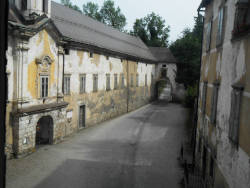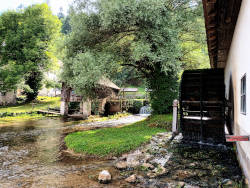Izviri v Bistri
Bistra Springs
Useful Information


| Location: |
At Grad Bistra.
A1 exit Vrhnika, left on 409 and again on 642 to Borovnica. Bistra is about 4 km from Vrhnika. (45.9476235, 14.3332812) |
| Open: |
MAR to MAY Tue-Fri 8-17, Sat, Sun, Hol 9-19. JUN to AUG Tue-Sun, Hol 9-19. SEP to DEC Tue-Fri 8-17, Sat, Sun, Hol 9-19. [2024] |
| Fee: |
Adults EUR 8, Children EUR 4, Students EUR 4, Seniors EUR 5, Families (2+2) EUR 16. Groups (20+): Adults EUR 6, Children EUR 3, Students EUR 3, Seniors EUR 4. [2024] |
| Classification: |
 Karst spring Karst spring
|
| Light: | n/a |
| Dimension: | |
| Guided tours: | self guided |
| Photography: | allowed |
| Accessibility: | yes |
| Bibliography: | |
| Address: |
Technical Museum Of Slovenia, Bistra 6, 1353 Borovnica, Tel: +386-1-750-66-70.
E-mail: |
| As far as we know this information was accurate when it was published (see years in brackets), but may have changed since then. Please check rates and details directly with the companies in question if you need more recent info. |
|
History
| 1257 | first written mention of Bistra as Frovnc. |
| 1306 | written mention as Vallis iocose. |
| 1350 | written mention as Freydenthall. |
| 1470 | written mention as Vistra. |
| 1481 | written mention as Bistrae. |
| 1220 | Carthusian monastery founded by Carinthian duke Bernard Spanheim. |
| 1260 | monastery completed by his son Ulrich Spanheim. |
| 1782 | monastery abolished by enlightened absolutist Joseph II. |
| 1826 | purchased by merchant and factory owner Franc Galle who reconstructed it, removing the last remnants of the monastery and turning it into a castle. |
| 1947 | building managed by the Forestry Institute of Slovenia to house the institute’s museum collections. |
| 1951 | Technical Museum of Slovenia founded on the initiative of Ciril Rekar and the Association of Engineers and Technicians. |
| 1953 | Technical Museum of Slovenia opened to the public. |
| 1999 | monastery and its surroundings declared a Cultural Monument of national importance. |
Description


The river Ljubljanica, which flows through Slovenian Capital Ljubljana, is the river with seven names. A complex system of caves and poljes is the source of this river. It is called Ljubljanica when the water finally reaches the Ljubljana Marsh (Ljubljansko barje) at Vrhnika. Here is a huge number of springs, where the limestone ridge ends and the impermeable flysch plain begins. The four most important springs of Ljubljanica are Retovje, Močilnik, Bistra, and Lintvern.
Bistra was of importance because of its springs, so it is easy to understand why Grad Bistra (Bistra Castle) was built here. A part of the building is called Samostan Bistra (Bistra monastery), and while it is actually on the other side of the road, it is nevertheless part of the same building and connected at two points. It was a Carthusian monastery, which was founded around 1220 by Carinthian duke Bernard Spanheim and completed by his son Ulrich Spanheim in 1260. It became known as Carthusia Vallis Iocosa, and was supported by the counts of Celje. Its heydays were during the 14th century. A number of important illuminated manuscripts which were produced here, notable is a transcript of Aurelius Augustinus’ De Civitate Dei dating from 1347. Then came Turkish invasions, fires, earthquakes and the Protestant Reformation. The monastery was finally abolished by the enlightened absolutist Joseph II in 1782. He decreed the dissolution of monasteries across the Habsburg Empire. The abandoned monastery was owned by the district authorities, but sold in 1826 to the merchant and factory owner Franc Galle. He reconstructed the building completely, removed the last remnants of the monastery and turned it into a castle. So the reality is actually that this never was a castle, it was a monastery, and the castle is 19th century historism kitsch.
The water was used to fill the moat and to operate a sawmill and a blacksmith workshop. The river, formed by the main spring and several small springs, is called Bistra. It flows into the Ljubljanica after 2 km. It is famous for its trout and a popular spot for fishing.
The spring actually has an extension of more than 400 m, along the foot of the hill Javorč (605 m asl). Rather strange is the fact that the road was built along the foot of the hill, right on top of the springs, so it looks like the water flows out from under the road. There are four main springs, which are between 20 and 50 m wide, and each is collected by a dam and used to power some machinery with a waterwheel. The biggest spring is the first, when coming from Vrhnika, the one which is on the grounds of the castle, and while it is easily visible from the road, we strongly recommend to visit the museum. It is definitely interesting to walk over the various dams and through the buildings around the spring and see the wooden water wheels up close. The main spring has four outflows, and there was obviously a waterwheel on each of them, but today only one wooden wheel and a much younger steel wheel are still there.
The castle is also of interest because it houses the Tehniški muzej Slovenije (Technical Museum of Slovenia). This is a museum about the technology of the 19th and 20th century, with emphasis on the Slowenian history. As a result, wood is an important factor, and the exhibition includes the cutting, transport, the sawmills, and the further processing of the wood. After all, one of the buildings is a historic sawmill powered by the water of the spring. There are also exhibitions of bicycles, motorbikes, and cars, even lorries and other machinery like fire engines.
- See also
 Search DuckDuckGo for "Bistra Springs Vrhnika"
Search DuckDuckGo for "Bistra Springs Vrhnika" Google Earth Placemark
Google Earth Placemark OpenStreetMap
OpenStreetMap Bistra, Vrhnika - Wikipedia (visited: 09-OCT-2024)
Bistra, Vrhnika - Wikipedia (visited: 09-OCT-2024) Technical Museum of Slovenia (visited: 09-OCT-2024)
Technical Museum of Slovenia (visited: 09-OCT-2024) History (visited: 10-OCT-2024)
History (visited: 10-OCT-2024) Bistra Carthusian Monastery (visited: 09-OCT-2024)
Bistra Carthusian Monastery (visited: 09-OCT-2024) Bistra (visited: 09-OCT-2024)
Bistra (visited: 09-OCT-2024)
 Index
Index Topics
Topics Hierarchical
Hierarchical Countries
Countries Maps
Maps